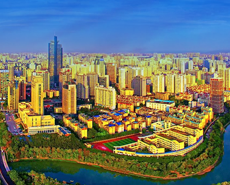
Secondary aluminum alloy market to recover in H2 2019
----Interview with Han Yaobin
Vice President
CSMET
Vice President
CSMET
CSMET is a large group engaged in professional research and development, production and sales of cast aluminum alloy ingot and aluminum liquid. Owning decades of aluminum alloy production experience, the group is a leading enterprise in Chinese secondary aluminum alloy industry. CSMET created aluminum liquid supply to customers directly on base of initial aluminum alloy sale from 2012, becoming one of the companies that can supply aluminum liquid directly within long and medium range. The company has six production bases respectively in Shanghai, Taicang, Suzhou, Henan, Chongqing and Huizhou and two dangerous goods transportation companies. The group is pushing ahead with the listing now.
Asian Metal: In Q4, primary aluminum prices have declined continuously. How did this affect your secondary aluminum alloy business?
Mr. Han: Primary aluminum market was sluggish in 2019 affected by supply-demand relation and international trade disputes, and the prices dropped even more noticeably in Q4. Secondary aluminum alloy prices typically fluctuate following primary aluminum prices, albeit with a lag. Prices for the raw material, aluminum scrap, also move with primary aluminum prices slightly. On the whole, the secondary aluminum market sees fierce competition in Q4 due to decreasing primary aluminum prices and less demand.

Asian Metal: Auto plants are the main customers for the secondary aluminum alloy industry. But the auto industry has been dull this year and has less demand for aluminum alloy castings, resulting in shrinking sales for some secondary aluminum alloy producers. How did your company cope with the situation?
Mr. Han: A company which wants to survive amid the fierce market competition should carefully watch and analyze the market. In order to cope with the changeable market environment, we enhanced our competitiveness years ago from three aspects. Firstly, we optimized customer base and improved customer concentration. Our key clients' orders account for 70% of the total sales and the high-and-middle end customers usually have stable demand. Secondly, we increased the investment in product application and focused on the development of emerging markets. We have made significant achievements in the communication industry and the consumption from non-aluminum industries accounts for about 35% of our production. Thirdly, we consistently improve creativity so as to upgrade products and optimize business pattern.

Asian Metal: The secondary aluminum alloy market is still sluggish in Q4, so how do you think of the industry next year? Will it have the chance to rebound late this year?
Mr. Han: The auto and communication industries are the main consumption industries for secondary aluminum alloy. The auto industry has grown slowly after experiencing rapid growth for over ten years. On the one hand, the auto policy for 2016-2017 led to sales of autos that should have been seen in 2019; the demand for fuel-consumption autos in 2019-2019 is not optimistic and is expected to decrease in 2019. On the other hand, as the auto industry developed rapidly from 2016 to 2017, the demand for secondary aluminum alloy rose sharply, so producers expanded production disorderly, leaving overcapacity in 2019; the situation would last till H1 2019. I think aluminum demand from the auto industry would remain weak in H1 2019; however, with higher requirement on light-weight autos, development of NEV and promotion of 5G, alongside with market competition and environmental protection, some secondary aluminum alloy companies might be shut down, then the market may improve in H2 2019.

Asian Metal: The environmental protection policy is still strict this year and most substandard companies have been rectified. How do you think of the policy next year?
Mr. Han: The environmental protection policy would not loosen but would be more rational in the future. Actually, it would be good for companies which meet the environmental protection standard. China’s reform and opening-up has brought robust economic growth to the country and tremendous changes to people’s lives. The environmental problem has become an urgent issue that we need to solve and attach importance to. Therefore, the policy will be upheld for a long time. As a secondary aluminum alloy enterprise, we would strictly abide by environmental protection policy during production.

Asian Metal: CSMET mainly supplies aluminum liquid for customers directly. What's the advantage of the direct supply, and would it become the main trend in the future?
Mr. Han: Direct supply for aluminum liquid stemmed from European, American and Japanese countries; it developed quickly in China in recent years. The advantages are as follows: Die-casting plants could save cost of RMB600-1,000/t (USD87-145/t) and cut carbon emission as they need not to resmelt; meanwhile, the cost of labor, power, facility maintenance and auxiliary material could be cut and no funds shall be paid for stocking. The direct supply could also reduce the burning loss to about 2% and improve metal recovery. What's more, the direct supply would be helpful for companies to establish cooperation with customers.

Asian Metal: It is said that the secondary aluminum alloy would see overcapacity this year, but the plants in Henan and Huizhou of CSMET both went into operation as scheduled. Why are you so confident about the industry?
Mr. Han: Firstly, the secondary aluminum alloy industry is an industry encouraged by the country for circular economy development; it is good for developing the eco-friendly and resource-saving society. Secondly, aluminum products are widely applied in industries and civil works after years of development, especially after the rapid development of 2000. Earlier aluminum products will be recycled gradually at the end of their life cycle. The year from 2025 to 2030 would witness a recycling peak when the secondary aluminum alloy market would see abundant raw material supply. Thirdly, secondary aluminum alloy has been applied in auto, communication and electronics industries and would be applied in more areas with technology development.














